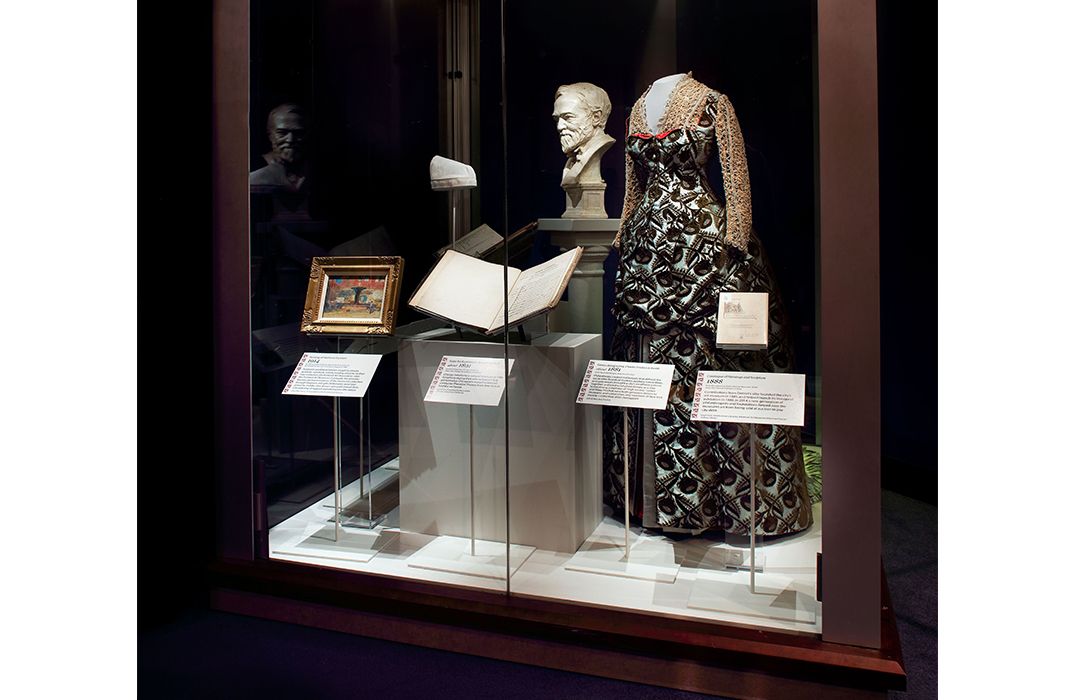The Day a Bunch of Billionaires Stopped by the Smithsonian
A new effort to study the history of philanthropy is announced and a number of significant charitable contributions are recognized
:focal(546x286:547x287)/https://tf-cmsv2-smithsonianmag-media.s3.amazonaws.com/filer/14/ef/14efdec8-42c9-4a6a-b248-5b58eaa1326d/jnb1130150113axweb.jpg)
A bevy of billionaires, including Bill and Melinda Gates, Warren Buffett and Ted Turner, joined Smithsonian officials last week, to launch an initiative to research and document the country’s philanthropic history and its role in shaping the nation.
“Expansive, active, results-driven philanthropy is a particularly American innovation, a type of philanthropy that reflects the core values and character of this nation,” said Smithsonian Secretary David J. Skorton.
As part of the program, the Smithsonian’s National Museum of American History hosted a half-day symposium to explore philanthropy’s impact on American life. Designed to examine the power and impact of all types of giving, the Smithsonian initiative supports an annual symposium, an exhibition display and endows a curatorial position.
Launched on the fourth anniversary of the annual #GivingTuesday, a global outpouring of donations fueled by social media, the movement’s creator Henry Timms, director of the 92nd Street Y, a New York City community and cultural center, was on hand as one of the featured speakers. According to Timms, more than 40,000 organizations participated this year and raised more than $116 million.
It was on #GivingTuesday this year that Facebook founder Mark Zuckerberg and his wife Priscilla Chan honored the birth of their daughter Maxima with a pledge to donate 99 percent of their Facebook shares, valued at $45 billion, to a new limited liability corporation known as the Chan Zuckerburg Initiative. (Critics quickly jumped in to question the unusual arrangement because the new entity does not have nonprofit status.)
By contrast, the Smithsonian philanthropy initiative sparked little in the way of controversy, but a powerhouse of beneficient donors witnessed as museum director John L. Gray accepted into the collections a simple relic of American charity—a firefighter's boot.
The scuffed and careworn artifact, sporting stickers for muscular dystrophy, along with a sign used to gather money from motorists at traffic light intersections was donated by fire and rescue personnel from Fairfax County, Virginia. The crew has set national records for their charitable solicitations.
Gray also accepted signs and a banner from Jamie McDonald, the founder of Generosity Inc., who ran the BMoreGivesMore campaign during #GivingTuesday 2013, and which raised $5.7 million—earning Baltimore the moniker #MostGenerousCity.
When the lights dimmed suddenly and dramatically, a textile conservator wheeled out the fragile three-piece silk suit that Benjamin Franklin wore to secure the 1778 Treaty of Alliance with France. The rare artifact prompted oohs and aahs from the audience and Gray noted a historic first in the art of giving by none other than Franklin himself. Known as the father of American philanthropy, Franklin’s pioneering efforts to collect money from all who would benefit helped to build the nation’s first hospital and public subscription library.
“Franklin introduced an alternative way of thinking about the improvement of mankind, a way that proved to be more democratic, egalitarian, creative and resourceful, much like the new nation itself,” Gray reminded them.
David Rubenstein, co-founder and co-CEO of the Carlyle Group and a member of the Smithsonian Board of Regents, later moderated a panel that examined the past century of American philanthropy. He asked Warren Buffett, chairman and CEO of Berkshire Hathaway holding Inc., about the origins of The Giving Pledge, a commitment by the world’s wealthiest individuals and families to dedicate the majority of their wealth to philanthropy.
Buffett, who still lives in the same modest house in Omaha, Nebraska, that he purchased in 1958, explained that it was an idea developed in 2010 with Bill and Melinda Gates, David Rockefeller Sr., and others after a serious slump in philanthropic giving followed the 2007 financial crisis. Currently, 139 individuals and families have signed the pledge. A rotating selection of these pledge letters is on view as part of the Smithsonian’s philanthropy exhibit.

Buffett has promised about 95 percent of his estimated $64 billion fortune to five philanthropies, including the Bill & Melinda Gates Foundation. He described the thinking behind his bequests.
“When we were in our 20s, my wife and I decided that we would give away all the money that we didn’t need, and basically, we didn’t think we would need that much,” he said. “Originally, I thought that my first wife would outlive me and I would do ‘the piling up’ and she would do ‘the unpiling,’ but when she died first, I had to have a plan that made sense.“
Buffet, 85, also made it clear that he wants all his funds to be spent within 10 years after his estate is settled. “I do not believe in trying to figure out what the needs of the world are going to be,” he continued.
“You won’t be looking down to see what’s happening?” asked Rubenstein.
“I’ll be looking up, actually,” he quipped.
Rubenstein, who’s estimated worth is $2.8 billion, also signed the Giving Pledge after reading an article detailing that the average, white male lived to be 81.
“I realized that I had lived two-thirds of my normal expected life and I could either take all my money and be buried with it and have an executor give it away, or I could give it away while I was alive,” he said. “I realized that I had made a lot more money than I really needed and my family needed, so I started the process of giving it away.”
Among the many projects to which he has donated are repairs to the Washington Monument after earthquake damage, the purchase of a copy of the Magna Carta for permanent display at the National Archives, the endowment of the panda habitat at the National Zoo, and repairs at both George Washington’s Mount Vernon, and Thomas Jefferson’s Monticello.
Rubenstein, along with the Bill & Melinda Gates Foundation, endowed the Smithsonian’s Philanthropy Initiative, to among other things, encourage people of every income level to give back.
“My goal has been to expand the concept of philanthropy beyond rich people writing checks," he said. "Money does not have to be the only way that you measure philanthropy. It can be about your energy, your time, your ideas or your volunteerism.”
In another panel discussion, Melinda Gates explained how she and her husband Bill narrowed their philanthropic focus since they started their foundation in 2000. Bill Gates has an estimated worth of more than $79 billion.
“Warren gave us really good advice early on. To figure out who we are and what we cared about deeply and then to define our bull’s-eye and the rest would sort of fall away. I still feel badly if we don’t give to lung cancer, but I know that others are doing that,” said Gates.
“The other great advice that he gave was ‘swing for the fences.’ These are hard problems that society has left behind, so you’ve got to take risks and not everything is going to work, and you are going to do a few things that might look foolish, but that’s OK. You have to take on these tough problems and I have to get comfortable being uncomfortable, and that’s the most important lesson I’ve learned,” she continued.
The Gates Foundation primarily focuses on global health, global poverty reduction and K-12 education in the United States.
Philanthropy has always been close to the Smithsonian’s heart. The Institution itself was founded by an act of individual giving. James Smithson, a British scientist, left his estate to the United States in 1829 for “an establishment for the increase and diffusion of knowledge.” This year marks the 250th anniversary of Smithson’s birth. As well, the treasures that make up the vast majority of the Institution’s collections are often donated.
The National Museum of American History will open the first, full-scale philanthropy exhibition entitled “Giving in America” on #GivingTuesday 2016. The preview case currently on view focuses on how philanthropy has shaped civic culture in both the Gilded Age (1870 – 1900) and the present day.
/https://tf-cmsv2-smithsonianmag-media.s3.amazonaws.com/accounts/headshot/Lucy_Harvey_151120_1745_WEB.jpg)





/https://tf-cmsv2-smithsonianmag-media.s3.amazonaws.com/accounts/headshot/Lucy_Harvey_151120_1745_WEB.jpg)